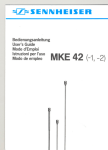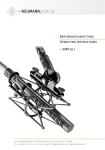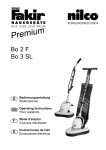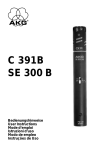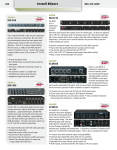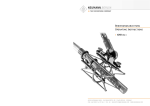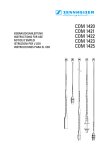Download Sennheiser MKH 816 User's Manual
Transcript
!Zj SENNHEISER Bedienungsanleitung User's Guide Mode d'Emploi Studio-Richtmikrofon DirectionalStudio Microphone Microphone directionnel de studio MKH816 P48 U 3 Speisung und Anschluß Powering and connection Alimentation et branchement Frequenzgang Frequency response Courbe de frequence Speisung I Powering I Alimentation Phantomspeisung 48 V nach DIN 45596 Phantom powering 48 V according to DIN 45596 Alimentation a circuit tantöme 48 V selon DIN 45596 dB SO - ~O - - - 30 i-- T : :, 20 :--l ~ L--_L_- :, , (-; '___i3L~, ---r---'1L---~'-/: 3 r' I[ MKH 816P48U3 10 oder wahlweise 3,3kQ alternatively 3,3kQ ou alternativement 3,3kQ m 0 20 50 100 200 500 1000 2000 5000 10000 20000 Hz Anschluß I Connection I Branchement Anschluß an syrnrnetrisch-erdtreie Mikrofoneingänge Connection to balanced, floating microphone inputs Raccordement a des entrees de microphone symetriques, sans mise a la terre Solltrequenzgang mit Toleranzschema Standard response curve with tolerances Courbe de reponse de consigne avec tolerance Jedem Mikrofon legen wir das Original-Meßprotokoll bei, gemessen von 50. .20000 Hz rh-~' The original diagram is included with each microphone, measured from 50. .20000 Hz i, Chaque micro est livre avec I'original du proces-verbal des mesures entre 50...20000Hz ,, MKH816P48U3 --- . '. :, MZA14P48 MZN16P48 , 0..---~ L 4~:_:::-_n( Richtdiagramm Directional pattern Diagramme de directivite Anschluß an unsymmetrische Mikrofoneingänge Connection 10unbalanced microphone Inputs Ra~cordement a des entrees de microphone asymetnques -~ MKH816P48U3 r--, , ~ i ...: - - _-, ,I :. <---:- -, MZA14 P 48 I I MZN16P48 ~.L-~ 90' 90'1 ( 125 Hz-...250 Hz-..500 Hz-.1000 Hz- , ,, 180" 2000 Hz4000 Hz-.8000 Hz-..16000Hz-...- ~ Anschluß an Mischpulte und Tonaufzeichnungsgeräte mit Speisemöglichkeit Connection to mixers and recording equipment with built-in microphone power supply Raccordement ades pupitres de melange el des consoles d'enregistrement avec possibllite d'alimentation MKH816P48U3 -- ~mml.0D[ . L u-- ------------- Inhaltsverzeichnis Kurzbeschreibung. . . . . . . . . . . . . . . . . . . . . . . . . . . . . . . . . Prinzipder Hochfrequenzschaltung. . . . . . . . . . . . . . SpeisungundAnschluß. . . . . . . . . . . . . . . . . . . . . Seite 3 3 3 STUDIO-RICHTMIKROFON MKH 816 P 48 U 3 Lieferumfang: 1 Mikrofon Anschluß an symmetrisch-erdfreie Mikrofoneingänge. . . . . . . . . . . . . . . . . . . . . . . . . Anschluß an unsymmetrische Mikrofoneingänge. . . . . . Anschluß an Mikrofoneingänge mit hoher Empfindlichkeit. . . . . . . . . . . . . . . . . . . . Anschluß an Mischpulte und Tonaufzeichnungs- gerätemitSpeisemöglichkeit.. . . . . . . . . . . . . . . . . Technische Daten.. . . . . . . . . . . . , . . . . . . . . . . . Zubehör. . . . . . . . . . . . . . . . . . . . . . . . . . . . . . . 4 4 4 4 5 5/6 Contents Generaldescription. . . . . . . . . . . . . . . . . . . . . . . . Principleof highfrequencycircuit . . . . . . . . . . . . . . . Poweringandconnections. . . . . . . . . . . . . . . . . . . Page 7 7 7 Connection to balanced, floatingmicrophoneinputs. . . . . . . . . . . . . . . . . . . Connectionto unbalancedmicrophoneinputs. . . . . . . Connectionto microphoneinputs . withhighsensitivity. . . . . . . . . . . . . . . . . . . . . . . . Connection to mixers and sound recording equipment with powering facilities . . . . . . . . . . . . . . . Technical Data . . . . . . . . . . . . . . . . . . . . . . . . . . . Accessories ............................ 8 8 8 8 9 9/10 Sommaire entrees micro mise Eila terre .............. entrees micro asymetriques entrees micro Page 11 11 11 . . . . . . 12 12 Eihautesensibilite. . . . . . . . . . . . . . . . . . . . . . . . . 12 Branchement Eides pupitres de melanger et des appareils d'enregistrement avec possibilitesd'alimentation. . . . . . . . . . . . . . . . . . . . Caracteristiques techniques. . . . . . . . . . . . . . . . . . . Accessoiresspeciaux ...................... 2 Seine Merkmale . Hoher Bündelungsgrad . Sehr gute .Rückkopplungsdämpfung . Niedriger Aquivalentschalldruckpegel . Robust und extrem klimafest . Hoher Feldleerlauf-Übertragungsfaktor . Ganzmetallgehäuse, mattschwarz eloxiert Prinzip der Hochfrequenzschaltung Descriptionabregee ....................... Montagehautefrequence. . . . . . . . . . . . . . . . . . . . Alimentationet branchement. . . . . . . . . . . . . . . . . . Branchement Eides symetriques et sans Branchement Eides Branchement Eides Kurzbeschreibung Das MKH 816 P 48 U 3 ist ein Studio-Richtmikrofon mit hohem Bündelungsgrad. Eswird besonders im Film- und Fernsehbetrieb und auch bei Außenreportagen verwendet. Das Mikrofon arbeitet nach dem bewährten Hochfrequenz-Prinzip von Sennheiser electronic und ist für 48-V-Phantomspeisung ausgelegt. Die Kapsel eines Kondensatormikrofons in Hochfrequenzschaltung stellt im Gegensatz zu der Niederfrequenzschaltung eine niederohmige Impedanz dar. An der Kapsel liegt anstelle der sonst nötigen hohen POlarisationsspannung lediglich eine Hochfrequenzspannung von weniger als 10 V, die durch einen rauscharmen Oszillator (8 MHz) erzeugt wird. Dieses Arbeitsprinzip führt zu einer höheren Betriebssicherheit der Mikrofone, insbesondere bei Außenaufnahmen unter extremen klimatischen Verhältnissen. Speisung und Anschluß 12 13 13/14 Alle Kondensatormikrofone von Sennheiser electronic mit der Bezeichnung MKH . . . P 48 werden nach DIN 45596 mit 48 V phantomgespeist. Die beiden Tonadern führen die positive Speisespannung, die Rückleitung des Speisestroms erfolgt über den Kabelschirm. Beim Anschluß der Sennheiser-Kondensatormikrofone wird ebenso wie bei dynamischen Mikrofonen vom Prinzip der Spannungsanpassung Gebrauch gemacht. Der Vorteil ist dabei, daß weder der Impedanzverlauf des Mikrofonausganges noch der des Verstärkereinganges einen nennenswerten Einfluß auf den Gesamtfrequenzgang haben. Die Quellimpedanz der Sennheiser-Kondensatormikrofone mit Phantomspeisung ist so klein (etwa 100 bei 1000 Hz), daß von der Eingangsimpedanz des Verstärkers nur verlangt wird, daß sie mindestens 600 0 beträgt. Das ist meist der Fall. Sollte dennoch ein Eingang mit geringerer Impedanz vorliegen, so muß man mit einem geeigneten Vorwiderstand dafür sorgen, daß das Mikrofon mindestens 600 0 »sieht«. Die dabei auftretende Spannungsteilung muß natürlich berücksichtigt werden. Dieselbe Methode wird angewandt, wenn eine höhere Ausgangsimpedanz des Mikrofons verlangt wird. Auch in diesem Fall kann man sich durch Vorschalten eines entsprechenden Widerstandes helfen. 3 J Die Sennheiser-Kondensatormikrofone geben relativ hohe Spannungen ab, bei maximalen Schalldrücken mehr als 1 V. Das hat den Vorteil,daß auch bei großen Kabellängen eingekoppelte Störspannungen keine Bedeutung erlangen. Weiterhin geht auch das Eigenrauschen des Mikrofonverstärkers kaum noch in das Gesamtrauschen ein. Die Mikrofone sind außerdem mit reichlich bemessenen Hochfrequenz-Siebgliedern ausgestattet, die dafür sorgen, daß keine Hochfrequenzspannungen auf die Mikrofonleitungen gelangen, und die gleichzeitig die Mikrofone gegen Hochfrequenzstörungen von außen schützen. Es ist deshalb auch unter schwierigen Verhältnissen nicht notwendig, besondere Maßnahmen, wie Doppelabschirmung der Leitungen und hochfrequenzdichte Armaturen, vorzusehen. Sennheiser-Kondensatormikrofone sind nach DIN gepolt, d. h. bei Auftreten eines Druckimpulses von vorn auf die Kapsel tritt an Stift 2 eine positive Spannung gegenüber Stift 3 auf. Technische Daten MKH 816 P 48 U 3 Übertragungsbereich, Akustische Arbeitsweise Richtcharakteristik . , . , ,. . Feldleerlauf-Übertragungstaktor bei 1000 Hz, .,.,.,.., Elektrische Impedanz bei 1000 Hz Minimale Abschlußimpedanz Aquivalentschalldruckpegel nach CCIR 468-1 A-Kurve ., ,., bewertet .,., Aussteuerungsgrenze bei 1000 Hz , Speisespannung. Speisestrom. , , Temperaturbereich Stecker. , , Beschaltung , 40-20000 Hz Interferenzempfänger Superniere/Keule 40 mV/Pa:1c1dB ca, 10 Q, symmetrisch-erdfrel 600 Q (200 Q für Schalldrücke bis 15 Pa) 27 dB 16 dB 30 Pa . 48V:1c12V ca. 2 mA . -10°C bis + 70De 3pol. XLR-Stecker 1 : Masse, Gehäuse; Speisung H 2, NF (+); Speisung (+) 3: NF (-); Speisung (+) 19 O, 555 lang 375 9 mattschwarz Anschluß an symmetrisch-erdfreie Mikrofoneingänge Abmessungen In mm Gewicht, . Obertläche . In diesem Fall verbindet man das Mikrofon mit einem Netzgerät, z. B. MZN 16 P 48 oder Batterieadapter MZA14 P 48 (siehe Zubehör), und dessen Ausgang wiederum mit dem Verstärkereingang. Änderungen, vor allem zum technischen Fortschritt, vorbehalten, Anschluß an unsymmetrische Mikrofoneingänge Sollen phantomgespeiste Mikrofone über das entsprechende Versorgungsgerät an unsymmetrisch beschalt!3te Geräteeingänge angeschlossen werden, so ist generell ein Ubertrager zwischenzuschalten. Hierbei kann dann gleichzeitig durch richtige Wahl des Übersetzungsverhältnisses die geeignete ,$pannungsanpassung gemacht werden. Die Sekundärseite des Ubertragers kann dann unsymmetrisch mit dem Geräteeingang verbunden werden. Bei der Versorgung aus dem Batterieadapter MZA 14 P 48 oder dem Sennheiser-Netzgerät MZN 16 P 48 kann deren Ausgang direkt angeschlossen werden. Anschluß an Mikrofoneingänge mit hoher Empfindlichkeit Wenn der Mikrofoneingang eine zu hohe Eingangsempfindlichkeit besitzt,z. B. wenn er für niederohmige Mikrofone vorgesehen ist, kann es notwendig werden, den Pegel des Mikrofons mit Hilfe eines Spannungsteilers herunterzusetzen.Dieser ist in der Mikrofonleitung am Geräteeingang anzuordnen. Hierdurch wird in dem eigentlichen Mikrofonkreis der hohe Pegel bewahrt, was sich günstig auf den Störabstand auswirkt. Beispiel: :~: MKH 816 P 48 U 3 Anschluß an Mischpulte und Tonaufzeichnungsgeräte mit Speisemöglichkeit Wenn im Gerät eine Spannung von 48 V ::1::12 V zur Verfügung steht, kann das Kondensatormikrofon daraus direkt gespeist werden (siehe auch Abbildung »Speisung und Anschluß«). Die Spannung muß so stabilisiert und gesiebt sein, daß die Fremdspannung kleiner 1 mV ist. Die nach Norm vorgeschriebenen Speisewiderstände müssen einen Wert von 2 x ca. 6,8 kO haben. Die Abweichung der beiden Widerstände voneinander soll;;;; 0,4 lJIosein. Die Stromaufnahme von Sennheiser-Kondensatormikrofonen MKH. . . P 48 beträgt etwa 2 mA, es fallen also etwa 7 V an den Speisewiderständen ab. 4 Zubehör Federhalterung (Art.-Nr. 02992) MZS 16 Federhalterung mitgummigelagerten Kunststoffklammern. Sehr gute Körperschalldämpfung. Mit %"-Gewindebohrung zur Befestigung auf Stativen oder Mikrofonangeln. Pistolengriff MZP 816 (Art.-Nr.01932) für den Reportageeinsatz. f Windschutzkombination MZW 816 (Art.-Nr. 01930) Windschirm, Winddämpfung ca. 6 dB. ~ MZH816 (Art.-Nr.03186) Windschutzhülle zur Erhöhung der Windgeräuschdämpfung vom Windschirm um 15 dB. ,',. ' .,,"',',.'"",,' ""'",, " '"~-~. ,',';, ',' ',e""""', ",,' Windschutz MZW815 (Art.-Nr.0896) Schaumnetz-Windschutz mit guten Winddämpfungseigenschaften. Größter Durchmesser 52 mm, Länge 540 mm. 5 I .J Netzgerät MZN 16 P48 U (Art.-Nr.1241) DIRECTIONALSTUDIOMICROPHONE MKH816 P 48 U 3 Stromversorgungsgerät für 48-V-Phantomspeisung nach DIN45596. An jedes Netzgerät können gleichzeitigzwei Mikrofone angeschlossen werden. Abmessungen: 168 x 120x 50 mm. Extend of delivery: 1 microphone. General description The MKH816 P 48 U 3 is a directional studio microphone with a high directivityfactor. This is highly desirable in the film and TV studio and also outdoors for multipleapplications.The microphone employs the proven RF-principle for low noise, low interference operation. It is designed for 48 V phantom powering. Speiseadapter MZA14 P 48 (Art.-Nr.2034) Zur netzunabhängigen Spannungsversorgung von einem phantomgespeisten Kondensatormikrofon.Speisung nach DIN45596. Features Mit XLR-Buchsen. Anschlußkabel KA 7 U (Art.-Nr.1777) Kabel mit XLR-Steckverbindern (System Cannon). Länge: 7,5 m. Anschlußkabel KA 7 UN (Art.-Nr.2157) Geeignet für alle SennheiserMikrofone mit XLR-Steckverbindern (System Cannon). Geräteseitig 3pol., verschraubbarer Normstecker (z. B. T 3260001). Länge: 7,5 m. Weitere Informationen r ~~ L XLR-3-11 c ' '~ ~ XLR-3-11c . Allmetal housing withblack finish J ' J L T 3260001 finden Sie im Sennheiser-Gesamtkatalog. conditions . High sensitivity XLR-3-12C, r . High directionality . Low equivalent sound pressure level . Rugged and extremely resistant to unfavourable climatic Principle of high frequency circuit The capsule of a RF condenser microphone represents contrary to DC circuits a low impedance. Instead of the high polarisation voltage normally required, the capsule requires only a high frequency voltage of about 10 volts, which is produced bya built-in low-noise oscillator (8 MHz). This principle ensures the microphone's high operational reliability, particulary for outdoor recordings in extreme climatic conditions. Powering and connection All Sennheiser microphones designated MKH . . . P 48 are 48 V phantom-powered according to DIN 45596. Either condenser- or dynamic microphones from Sennheiser electronic employ the principle of voltage matching. This "no load condition" has the advantage that neither impedance variations of the microphone output nor of the amplifier input have a noticable influence on the total perfomance of the system (e. g. frequency response). The source impedance of Sennheiser condenser microphones with phantom powering is extremely low (about 10 V at 1000 Hz) so that the amplifier input impedance has only at least 600 O. This is usual in the majority of cases. Should - however the input impedance be smaller than 6000, a resistor of appropriate value should be placed in series with the microphone so that it "sees" at least 400 O. The voltage division caused by the series resistor must, of course, be considered. The same method can be used when higher output impedance of the microphone is demanded. In this case again, aseries resistor can be used to provide correct matching. Sennheiser condenser microphones produce relatively high output voltages exceeding 1 volt at maximum sound pressure levels. This has the advantage that even with long cables induced interference signals can be disregarded. Also the internal noise produced by the microphone does not contribute to the total noise level. The microphones are fitted with RF filters which ensure that no high frequency signals from the microphone can effect the external circuitry and that the microphone itself is protected from high frequency disturbance. It is therefore not necessary, even under the most difficult conditions, to take special precautions, such as double screening of the cables or the provision of high frequency filters. 6 I 7 I J Senn heiser condenser microphones are polarised according to DIN standard i. e. when apressure pulse strikes the capsule Irom the lront, pin 2 goes positive with relerence to pin 3. Technical Data MKH 816 P 48 U 3 Frequency response. Operating pnnciple . . . . Directional characteristic . . Sensltivity at 1000 Hz . . Imedance at 1000 Hz . Minimum load. . . . . . . . . . . . . . . Equivalent sound pressure level as per CCIR 468-1 Connection to balanced, floating microphone inputs In this case the microphone is simply connected via apower supply, e. g. MZN 16 P 48, or powering adapter MZA 14 P 48 (see accessories) to the inputs 01 the amplilier. Connection to unbalanced microphone inputs II the microphone is powered bya corresponding supply unit and is to be connected to unbalanced inputs it is generally necessary to use a translormer. The secondary 01 this audio-translormer may then be connected - one side grounded - to the input Proper voltage matching is achieved by selecting a suitable translormer ratio. II the powering adapter MZA 14 P 48 or the power supply unit MZN 16 P 48 is used a translormer is not required. curveA . . I Dimensions .1 ...... Maximal SPL . . . . Operating voltage. . Current consumption Temperature range. . . Output plug ... Pin connections. . in mm Weight. . . Finish . . . . . . 40-20000 Hz interference transducer clup shaped 40 mV/Pa:t1 dB approx. 10 0 balanced, floating 6000 (2000 for SPL up to 15 Pa) .27 dB .16 dB .30 Pa .48V:t12V . approx. 2 mA . -10°C to + 70oe 3-pin XLR plug . 1 : ground, housing; supply (-) 2: audio (+); supply (+) 3: audio (-); supply (+) according to lEe standard publication 268-14/2 . 19 </!,555 long .375 9 . dull black We reserve the right to alter speciflcations, especially with regard to techmcallmprovements. Connection to microphone inputs with high sensitivity II the amplilier being used has a very high input sensitivity, i. e. when it is normally intended lor use with dynamic microphones, it can be necessary to reduce the output voltage Irom the microphone by means 01 a voltage divider. This should be built into the microphone cable at the amplilier input This way the large signal on the microphone cable is maintained up to just belore the microphone input, which helps to increase the signal to noise ratio. Example: , :~: , Accessories MKH 816 P 48 U 3 Shock Mount MZS 16 (Art-No. 02992) Shock mount with rubber suspended plastic elamps. Very Connection to mixers and sound recording equipment with powering facilities 900d sound insulation. With Ys"-thread lor mounting to microphone booms or tripods. II an d. c. voltage 0148 V :t12 V is available the condenser microphone can be powered directly (see also ligure "Powering and connection"). The voltage should be stabilised and liltered, so that the unweighted noise voltage is less than 1 mV. According to the DIN standard the two leed resistors should be approx. 6.8 kO. The difference between the two resistors should be ;;;; 0.4 %. The current taken by Sennheiser condenser microphones MKH . . . P 48, is approx. 2 mA. This means approx. 7 volts are lost ac ross the resistors. f Pistol grip MZP 816 (Art.-No.01932) lor reporting use. J I Windscreen combination MZW 816 (Art.-No. 01930) Windsereen, wind damping approx. 6 dB. MZH 816 (Art.-No.03186) Windsereen eoat, serves to increase the wind damping 01 the windscreen by 15 dB. ~ . . ",',', , ,.' ",', ". ~. ' ".',", ' . '. Windshield MZW 815 (Art.-No. 0896) Foam-rubber -wi ndsh ield. Largest diameter 52 mm, length 540 mm. 8 9 Power supply unit MZN 16 P 48 U (Art-No. 1241) Power supply unit for 48 V phantom powering according to DIN 45596. Two microphones can be powered simultaneously from each supply unit Dimensions: 168 x 120 x 50 mm. MICROPHONE DIRECTIONNEL DE STUDIO MKH 816 P 48 U 3 Livraison: 1 microphone. Powering adapter MZA 14 P48 (Art-No. 2034) Mains independent powering adapter for voltage supply of one phantom-powered condenser microphone. Powering according to DIN 45596. With XLR-plugs. Connecting cable KA 7 U (Art-No. 1777) Cable fitted with XLR-connectors (system Cannon). Length of cable: 7.5 m. ~ -, ~~ L XLR-3-11c Connecting cable KA 7 UN (Art-No. 2157) Suitable fex all Sennheiser mlcrophones equipped with XLR-connectors (Cannon). The cable is fitted with a 3-pin XLR-connector on one end and a 3-pin screwable standard plug (e. g. T 3260 001) on the other end. Length of cable: 7.5 m. , r '~ ~ Caracteristiques Directivite elevee Tres bonne attenuation de reaction acoustique Niveau de pression acoustique equivalente bas Robuste et extremement resistant au conditions climatiques defavourables . Facteur de transmission a vide elevee . Boiter metallique, surface noire mate J , Montage haute frequence L XLR-3-11C abregee Le MKH 816 P 48 U 3 est un microphone directionnel de studio a taux de directivite elevee, utilise en particulier par les chaines de film et television et aussi pour des prises de san a I'exterieur. Le montage HF tres eprouve de Sennheiser electronic a ete choisi pour ce micro qui est prevu pour une alimentation a circuit fantome de 48 V. Comme le micro ne possede pas de transformateur, il est insensible aux champs magnetiques parasitaires. . . . . XLR-3-12C r Description Contrairement au montage basse frequence, la capsule d'un micro electrostatique a haute frequence presente une faible impedance. A la place de la tension de polarisation relativement elevee, la capsule n'est soumise qu'a une faible bruit de fond. La faible impedance du systeme mene a une haute fiabilite des microphones, particulierement au cas des prises de san a I'exterieur aux conditians climatiques extremes. J T 3260001 Alimentation et branchement Further information you will find in the Sennheiser catalogue. ... . Taus les micros electrostatiques de Sennheiser electronic avec la designation MKH . . . P 48 so nt alimentes par circuit fantome de 48 V selon DIN 45596. Le courant passe par les deux conducteurs de modulation, le courant de retour par le blindage. Pour le branchement de ses microphones electrostatiques, Sennheiser utilise, comme pour les microphones dynamiques, le principe d'adaptation en tension. Cela signifie que I'impedance d'entree de I'amplificateur est beaucoup plus elevee que celle du micro de teile sorte que celui-ci marche presque a video Oe ce fait, ni les variations d'impedance du microphone, ni celles de I'amplificateur n'ont d'influence sensible sur la courbe de reponse. L'impedance de source des microphones electrostatiques Sennheiser a alimentation fantome est tres faible, environ 10 0 a 1000 Hz. La seule exigence posee a I'amplificateur est d'avoir une impedance d'entree d'au moins 600 O. Si toutefois, votre amplificateur presente une impedance inferieure, il faut choisir une resistance additionelle convenant pourque le micro «voie» au moins 600 O. La division de tension qui en resulte doit evidemment etre prise en consideration. La me me methode est employee si on a besoin d'une impedance micro plus elevee. Dans ce cas aussi, une resistance additionelle mene a une adaptation correcte. 10 11 Les micros electrostatiques Sennheiser donnent des tensions de sortie relativement elevees, superieures a 1 V pour des pressions acoustiques maximales. L'avantage en est que, meme pour des cables longs, les tensions parasitaires n'ont aucune influence. En outre, I'influence du bruit de fond de I'amplificateur du micro est pratiquement inexistante. De plus, tous ces micros Sennheiser sont equipes de filtres haute-frequence dimensionnes genereusement. Ces filtres eliminent les tensions parasites HF de la ligne et protegent les microphones co nt re des champs HF exterieurs. Meme pour des conditions difficiles de transmission, il n'est pas necessaire de prevoir de protections special es (douple blindage de lignes, materiel anti-HF, etc.). La polarite des micros Sennheiser est conforme a la norme DIN, c. a. d. si une impulsion de pression touche la capsule de front, la broche 2 possede une tension positive par rapport a la broche 3. Caracteristiques techniques MKH 816 P48 U 3 Bande pas sante. , , Pnncipe acoustique ., Directlvite , , . , . , , . . ' , . , , , t. Branchement a des entrees micro symetriques et sans mise a la terre 40-20000 Hz , capteur d'interferences lobe Facteur de transmission it vlde it 1000 Hz . . , . , , . , , . . , , . . 40 mV/Pa:t1 dB Impedance it 1000 Hz . . , , . . , . env.lO 0, symetnque, sans masse Impedance minimale de charge, , . 6000 (2000 jusqu'it 15 Pa) Niveau de pression acoustique selon .27 dB CCIR 468-1 ...... .16 dB DIN 45500, courbe A . , 30 Pa Niveau max, it 1000 Hz , 48 V :t 12 V Tension d'alimentation . , env, 2 mA Consommation , . , , , -10°Cit+70°C Plage de temperatures Connecteur, . , , fiche tripolaire XLR-3 , 1 : masse, boitier; alimentation H Brochage ' 2: BF (+); aiimentation (+) 3. BF (-); alimentation (+) Dimensions en mm. , , 19 i/), longueur 555 Poids. , . 375 g Modifications, surtout dans I'interet du progres technique, reservees, Dans ce cas on relie le micro a un bloc d'alimentation secteur, p. ex. MZN 16 P 48, ou a I'adapteur d'alimentation MZA 14 P 48 (voir :J.ccessoires) et la sortie du MZN resp. MZA a I'entree de I'amplificateur. Branchement a des entrees micro asymetriques Si des micros a alimentation fantöme doivent etre branches ades entrees asymetriques, en passant par I'alimentation secteur approriee, un transformateur doit etre intercale. En choisissant correctement le rapport de transformation, on arrive a I'adaption en tension adequate. Le cöte secondaire du transformateur peut alors etre branche de fayon asymetrique a I'entree de I'amplificateur. En utilisant I'adapteur d'alimentation MZA 14 P 48 ou I'alimentation secteur MZN 16 P 48 on peut connecter le microphone directement. Accessoires Suspension elastique MZS 16 (No. d'art 02292) Suspension elastique avec pinces en matiere plastique supportes de caoutchouc. Isolement acoustique tres efficace. Equipee d'un taraudage de %" pour montage sur perches de microphone ou sur pied. Branchement a des entrees micro a haute sensibilite Si I'entree micro possede une sensibilite trop elevee (p. ex. s'il est prevue pour micros dynamiques a basse' impedance) il est parfois necessaire de diminuer la tension du micro a I'aide d'un diviseur de tension. Celui-ci doit etre incorpore au cable du micro a I'entree de I'amplificateur. Le niveau eleve est ainsi maintenu jusqu'a I'entree du microphone, ce qui propice au rapport signal/bruit. Exemple: :~: MKH 816 P 48 U 3 Branchement ades pupitres de melange et des appreils d'enregistrement avec possibilites d'ali mentation Si I'appareil possede une tension de 48 V ::1::12 V, le microphone electrostatique peut etre alimente directement (voir aussi la figure «Alimentation et branchemenl»). La tension doit etre stabilisee et filtree de teile maniere que la tension non-ponderee soit inferieure a 1 mV. La valeur des resistances standardisees d'alimentation doit etre de 2 x 6,8 kO, la variation d'une resistance par rapport a I'autre ~ 0,4 %. Le courant de consommation pour les micros electrostatiques Sennheiser MKH . . . P 48 est d'environ 2 mA. La chute de potentiel aux deux resistances est d'environ 7 V. 12 .00 Poignee pistolet MZW 816 (No. d'art. 01932) Destinee pour les reportages. .. Combination anti-vent MZW 816 (No. d'art. 01930) Bonnette anti-vent, attenuation de 6 dB des bruits de vent. MZH 816 (No. d'art. 03186) Enveloppe de bon nette antivent, sert a elevee l'aMnuation des bruits de vent a 15 dB. ~ f ~ " >'H, ,"',', " ,," " ,','" ,',. "":~':'" "".:,,~..~.-~,' Bonnette anti-vent MZW 815 (No. d'art. 0896) Bonnette anti-vent en mousse acoustique speciale pour une protection efficace contre les bruits de vent. Diametre max. 52 mm, longueur 540 mm. 13 Bloc d'alimentation MZN 16 P48 (No. d'art. 1241) secteur Bloc d'alimentation Ei circuit fantome 48 V, conforme Eila norme DIN 45596. A chacun de ces types de blocs d'alimentation peuvent iHre raccordes deux microphones Eila fois. Dimensions: 168 x 120 x 50 mm. Adapteur d'alimentation MZA 14 P 48 (No. d'art. 2034) Pour I'alimentation d'un microphone electrostatique independante de reseau selon DIN 45596. Avec prises XLR. KA7U . (No. d'art. 1777) Cable avec connecteurs (sy~teme Cannon). Longueur: 7,5 m. XLR Pour plus d'information ~: L XLR-3-11C Cäble de raccordement KA 7 UN (No. d'art. 2157) Pour tous microphones Sennheiser avec Eifiche XLR (Cannon). Equipe cote appareil d'un connecteur tripolaire vissable (e. p. T 3260001). Longueur de cable: 7,5 m. 14 , r Cäble de raccordement '~ J XLR-3-12C r-----------. ~ J L XLR-3-11C T 3260001 voir le catalogue «Revue» de Sennheiser. SENNHEISER ELECTRONIC KG. 0-30900 WEOEMARK TELEFON 0 51 30/600-0 TELEX 9 24 623 TELEFAX 0 5130/6312 Printed in Germany Publ. 6/92 18344/ AO3
This document in other languages
- français: Sennheiser MKH 816
- Deutsch: Sennheiser MKH 816














